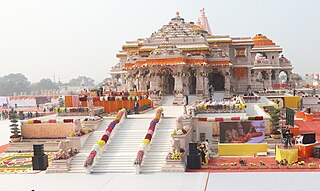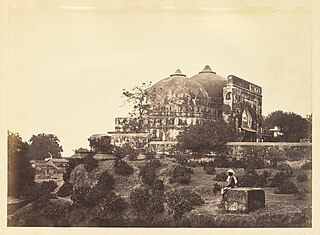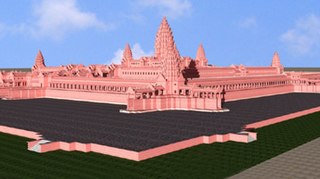Related Research Articles

Ayodhya is a city situated on the banks of the Sarayu river in the Indian state of Uttar Pradesh. It is the administrative headquarters of the Ayodhya district as well as the Ayodhya division of Uttar Pradesh, India. Ayodhya became the top tourist destination of Uttar Pradesh with 110 million visitors in the first half of 2024, surpassing Varanasi.

Babri Masjid was a mosque in Ayodhya, India. It has been claimed to have been built upon the site of Ram Janmabhoomi, the legendary birthplace of Rama, a principal deity of Hinduism. It has been a focus of dispute between the Hindu and Muslim communities since the 19th century. According to the mosque's inscriptions, it was built in 1528–29 by Mir Baqi, a commander of the Mughal emperor Babur. Before the 1940s, the masjid was officially known as "Masjid-i-Janmasthan". The mosque was attacked and demolished by a Hindu nationalist mob in 1992, which ignited communal violence across the Indian subcontinent.
Ram Janmabhoomi is the site that, according to Hindu religious beliefs, is the birthplace of Rama, the seventh avatar of the Hindu deity Vishnu. The Ramayana states that the location of Rama's birthplace is on the banks of the Sarayu river in a city called "Ayodhya". Modern-day Ayodhya is in the north Indian state of Uttar Pradesh. It is contested whether the Ayodhya mentioned in the Ramayana is the same as the modern city.
The Liberhan Commission was a long-running inquiry commissioned by the Government of India to investigate the destruction of the disputed structure Babri Masjid in Ayodhya in 1992. Led by retired High Court Judge M. S. Liberhan, it was formed on 16 December 1992 by an order of the Indian Home Union Ministry after the demolition of the Babri Masjid in Ayodhya on 6 December and the subsequent riots there. The commission was originally mandated to submit its report within three months. Extensions were given 48 times, and after a delay of 17 years, the one-man commission submitted the report to Prime Minister Manmohan Singh on 30 June 2009. In November 2009, a day after a newspaper published the allegedly leaked contents of the report, the report was tabled in Parliament by the Home Minister P. Chidambaram.
The archaeology of Ayodhya concerns the excavations and findings in the Indian city of Ayodhya in the state of Uttar Pradesh, much of which surrounds the Babri Mosque location.

The Ayodhya dispute is a political, historical, and socio-religious debate in India, centred on a plot of land in the city of Ayodhya, Uttar Pradesh. The issues revolve around the control of a site regarded since at least the 18th century among many Hindus to be the birthplace of their deity Rama, the history and location of the Babri Masjid mosque at the site, and whether a previous Hindu temple was demolished or modified to create the mosque.

Mahavir Mandir is a Hindu temple dedicated to the god Hanuman, located in Patna, Bihar, India. Millions of pilgrims visit the temple every year. Acharya Kishore Kunal is the secretary of the Mahavir Mandir Temple Trust, Patna.
Baqi Tashqandi, also known as Mir Baqi, was a Mughal commander (beg) originally from Tashkent during the reign of the first Mughal emperor Babur. He is widely believed to have been made the governor of the province of Awadh. He is believed to have demolished a Ram temple and constructed the Babri Mosque in Ayodhya in 1528, which later became the focal point of the Babri Masjid–Ram Janmabhoomi dispute.

The demolition of the Babri Masjid was carried out on 6 December 1992 by a large group of activists of the Vishva Hindu Parishad and allied organisations. The 16th-century Babri Masjid in the city of Ayodhya, in Uttar Pradesh, India, had been the subject of a lengthy socio-political dispute, and was targeted after a political rally organised by Hindu nationalist organisations turned violent.
Ram Janmabhoomi Nyas is an organisation which was formed as a trust to promote and oversee the construction of a temple in Ayodhya, India at the Ram Janmabhoomi, the reputed site of the birth of the Hindu deity Rama. The Nyas was formed by members of the Vishva Hindu Parishad.

Viraat Ramayan Mandir is a under-construction Hindu temple complex located at twin villages of Kaithawalia and Bahuara near Chakia in East Champaran district, Bihar, India. It is being built with a cost of 5 billion rupees and is planned to be 123 metres (405 ft) high, double height of Angkor Wat Hindu Temple in Cambodia, and to have a hall that seats 20,000 people. The construction of the temple was scheduled to start in June 2015, but has been delayed following the Cambodia government's protest to the government of India which successfully won over Temple construction. Virat ramayan mandir's fully financed by mahavir mandir patna trust and client is tata company, company which given the civil work to suntech infra solutions. Company which is Delhi based company. Which work in previous in many Bihar project like in ntpc, fertilizer and iocl barauni projects successfully. This work is planning to finished in 2026.

The Ram Rath Yatra was a political and religious rally that lasted from September to October 1990. It was organised by the Bharatiya Janata Party (BJP) and its Hindu nationalist affiliates, and led by the then-president of the BJP, L. K. Advani. The purpose of the yatra was to support the agitation, led by the Vishwa Hindu Parishad (VHP) and its affiliates in the Sangh Parivar, to erect a temple to the Hindu deity Rama on the site of the Babri Masjid.

Suraj Bhan (1931–2010) was an Indian archaeologist and professor of archaeology. His academic work was said to bear a deep imprint of Marxism. He was also involved with the work of Communist Party of India (Marxist) in Haryana and took particular interest in the People's Science movement.

Ram ke Naam is a 1992 documentary by Indian filmmaker Anand Patwardhan. The film explores the campaign waged by the right-wing Hindu nationalist organisation Vishva Hindu Parishad to build a temple to the Hindu deity Ram at the site of the Babri Masjid in Ayodhya, as well as the communal violence that it triggered. A couple of months after Ram ke Naam was released, activists of the VHP and other Hindu nationalist groups demolished the Babri Masjid in 1992, provoking further violence. The film earned Patwardhan a wide recognition, and received several national and international awards.
Bindeshwari Prasad Sinha (1919-2002) was an Indian archaeologist and historian specialising in ancient Indian history. Sinha was a professor and head of the Department of History and Archaeology at Patna University. He was the founder of Bihar state's Directorate of Archaeology and Museums. He was also the director of the K. P. Jayaswal Research Institute in Patna.
The Vishnu Hari inscription is the name given to a Sanskrit language inscription found in the Uttar Pradesh state of India. It records the construction of a temple by Anayachandra, a feudatory of the king named Govindachandra, and also contains a eulogy of Anayachandra's dynasty. Its date portion is missing, and its authenticity has been a matter of controversy.

Ayodhya is a legendary city mentioned in the ancient Sanskrit-language texts, including the Ramayana and the Mahabharata. These texts describe it as the capital of the Ikshvaku kings, including Rama.

The final judgement in the Ayodhya dispute was declared by the Supreme Court of India on 9 November 2019. The Supreme Court ordered the disputed land to be handed over to a trust to build the Ram Janmabhoomi temple. The court also ordered the government to give an alternative 5 acres of land in another place to the Uttar Pradesh Sunni Central Waqf Board for the purpose of building a mosque as a replacement for the demolished Babri Masjid.

The Ram Mandir is a partially constructed Hindu temple complex in Ayodhya, Uttar Pradesh, India. Many Hindus believe that it is located at the site of Ram Janmabhoomi, the mythical birthplace of Rama, a principal deity of Hinduism. The temple was inaugurated on 22 January 2024 after a prana pratishtha (consecration) ceremony. On the first day of its opening, following the consecration, the temple received a rush of over half a million visitors, and after a month, the number of daily visitors was reported to be between 100,000 and 150,000.

Mahant Nritya Gopal Das is the head of Ayodhya's largest temple, the Mani Ram Das Ki Chavani, and the chief of the Ram Janmabhoomi Nyas and Shri Ram Janmabhoomi Teerth Kshetra, bodies formed to undertake the construction of the Ram Mandir in Ayodhya. He is also the head of the Shri Krishna Janmasthan Seva Sansthan.
References
- ↑ Sahay, Ambikanand (1 September 2001). "Stone writ could hold key to Ayodhya". Times of India. Archived from the original on 20 June 2010. Retrieved 22 March 2011.
- 1 2 3 4 Amit Bhelari (19 December 2011). "Security at Mahavir Mandir is Ram bharose". The Telegraph (Calcutta). Archived from the original on 27 August 2013. Retrieved 3 December 2012.
- ↑ Jain, The Battle for Rama 2017, p. 6.
- ↑ Era ends at religious board, The Telegraph (Calcutta), 11 March 2016.
- ↑ "Kunal new head of Religious Trusts Board". Times of India. 26 May 2006.
- ↑ "Mahavir Mandir to have its twin in Houston". Times of India. 9 July 2009.
- ↑ Jha, Vinayanand (22 March 2004). "Cancer cases on rise due to change in lifestyle: Expert". Times of India.
- 1 2 Ram temple: 'I want to place rare evidence before SC', Rediff News, 3 May 2017.
- 1 2 Jain, Rama and Ayodhya 2013, pp. 166–167.
- ↑ Kunal, Ayodhya Revisited 2016, p. xxxviii.
- 1 2 Kuldeep Kumar, Re-examining an imbroglio, The Hindu, 10 December 2016.
- ↑ TNN (15 January 2008). "Guv hails services of Mahavir Temple". The Times of India . Archived from the original on 3 January 2013. Retrieved 20 January 2012.
- ↑ Pooja Kashyap (14 June 2011). "Plan to develop ancient temple". The Times of India . Archived from the original on 3 January 2013. Retrieved 20 January 2012.
- 1 2 3 "Acharya Kishore Kunal awarded". Jaindharmonline. 20 May 2008. Archived from the original on 13 July 2011. Retrieved 20 October 2010.
- ↑ Ayodhya Ram temple destroyed by Aurangzeb not Babbar: former Gujarat IPS officer, The Indian Express, 19 June 2016.
- 1 2 Ayodhya dispute: Aurangzeb, not Babar, built Babri masjid, says new book, Hindustan Times, 20 June 2016.